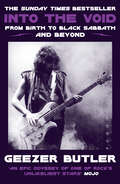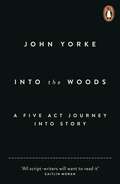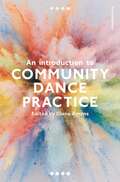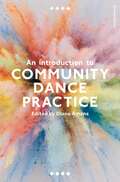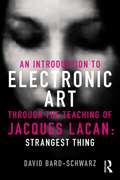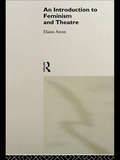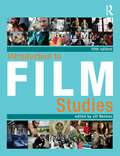- Table View
- List View
Into the Void: From Birth to Black Sabbath – and Beyond
by null Geezer ButlerA Rough Trade Book of the Year The Sunday Times bestseller The much-anticipated first book from Black Sabbath bassist Geezer Butler With over 70 million records sold, heavy metal pioneers Black Sabbath are one of the most influential bands of all time. From the very beginning, Geezer Butler was at the heart of their success. He named the group, provided the bass behind their distinctive sound and wrote the lyrics that resonated so powerfully with fans around the world. At long last, Geezer is ready to tell his side of the Sabbath story, from early days as a scrappy blues quartet through to the many lineup changes, the record-breaking tours and the international hell-raising with Ozzy Osbourne, Tony Iommi and Bill Ward. Featuring Geezer’s candid reflections on his working-class childhood in Luftwaffe-battered Birmingham, his almost-life as an accountant and his fascination with horror, religion and the occult, Into the Void reveals the softer side of the heavy metal legend, while holding nothing back. Like Geezer’s bass lines and the story of Black Sabbath themselves, Into the Void is original, dramatic and one hell of a ride.
Into The Woods: How Stories Work and Why We Tell Them
by John YorkeInto The Woods is a revelation of the fundamental structure and meaning of all stories, from the man responsible for more hours of drama on British television than anyone else, John Yorke.We all love stories. Many of us love to tell them, and even dream of making a living from it too. But what is a story? Hundreds of books about screenwriting and storytelling have been written, but none of them ask 'Why?' Why do we tell stories? And why do all stories function in an eerily similar way? John Yorke has been telling stories almost his entire adult life, and the more he has done it, the more he has asked himself why? Every great thinker or writer has their theories: Aristotle, David Hare, Lajos Egri, Robert McKee, Gustav Freytag, David Mamet, Christopher Booker, Charlie Kaufman, William Goldman and Aaron Sorkin - all have offered insightful and illuminating answers. Here, John Yorke draws on these figures and more as he takes us on a historical, philosophical, scientific and psychological journey to the heart of all storytelling.What he reveals is that there truly is a unifying shape to narrative - one that echoes the great fairytale journey into the woods, and one, like any great art, that comes from deep within. Much more than a 'how to write' book, Into the Woods is an exploration of this fundamental structure underneath all narrative forms, from film and television to theatre and novel-writing. With astonishing detail and wisdom, John Yorke explains to us a phenomenon that, whether it is as a simple fable, or a big-budget 3D blockbuster, most of us experience almost every day of our lives.
Introduction to Arts Management (Introductions to Theatre)
by Jim VolzIntroduction to Arts Management offers a unique, dynamic and savvy guide to managing a performing or visual arts organization, be that an arts center, theatre, museum, art gallery, symphony orchestra, or other arts company. For those training to enter the industry, workers in arts administration, or those seeking to set up their own company, the wealth of expert guidance and direct, accessible style of this authoritative manual will prove indispensable. Gathering best practices in strategic planning, marketing, fundraising and finance for the arts, the author shares practical, proven processes and valuable tools from his work with over 100 arts companies and professional experience producing over 100 music, dance, theatre and visual arts events. Unique features include:· boilerplate guides for marketing and fundraising · a sample Board of Trustee contract· specific budget checklists· day-to-day working tools that can be immediately instituted in any arts organization· resources at the end of each chapter designed to help readers consider and implement the strategies in their own practice. Interviews with arts leaders offer insights into the beginnings and growth of significant arts institutions, while examples based on real situations and successful arts organizations from both North America and Britain illustrate and underpin the strategic and practical advice. Expanded from the author's highly successful How to Run a Theatre, this edition offers both trainees and seasoned professionals the hands-on strategic leadership tools needed to create, build and nurture a successful career in the challenging world of arts administration and management.
Introduction to Arts Management (Introductions to Theatre)
by Jim VolzIntroduction to Arts Management offers a unique, dynamic and savvy guide to managing a performing or visual arts organization, be that an arts center, theatre, museum, art gallery, symphony orchestra, or other arts company. For those training to enter the industry, workers in arts administration, or those seeking to set up their own company, the wealth of expert guidance and direct, accessible style of this authoritative manual will prove indispensable. Gathering best practices in strategic planning, marketing, fundraising and finance for the arts, the author shares practical, proven processes and valuable tools from his work with over 100 arts companies and professional experience producing over 100 music, dance, theatre and visual arts events. Unique features include:· boilerplate guides for marketing and fundraising · a sample Board of Trustee contract· specific budget checklists· day-to-day working tools that can be immediately instituted in any arts organization· resources at the end of each chapter designed to help readers consider and implement the strategies in their own practice. Interviews with arts leaders offer insights into the beginnings and growth of significant arts institutions, while examples based on real situations and successful arts organizations from both North America and Britain illustrate and underpin the strategic and practical advice. Expanded from the author's highly successful How to Run a Theatre, this edition offers both trainees and seasoned professionals the hands-on strategic leadership tools needed to create, build and nurture a successful career in the challenging world of arts administration and management.
Introduction to Cinematography: Learning Through Practice
by Tania HoserIntroduction to Cinematography offers a practical, stage-by-stage guide to the creative and technical foundations of cinematography. Building from a skills-based approach focused on professional practice, author Tania Hoser provides a step-by-step introduction for both cinematographers and camera assistants to the techniques, processes, and procedures of working with cameras, lenses, and light. She provides hands-on insight on negotiating with production constraints and understanding the essentials of the image workflow from shot to distribution, on projects of any scope and budget. Richly illustrated, the book incorporates exercises and sample scripts throughout, exploring color, speed, movement ‘blocking’ and pacing scenes. As with all areas, the principles and techniques of shaping and controlling light are applied to working with natural light, film lamps, and low budget alternatives. This makes Introduction to Cinematography the perfect newcomer’s guide to learning the skills of cinematography that enables seamless progression from exercises through to full feature shoots. Assessment rubrics provide a framework to measure progress as the reader’s ability to visually interpret scripts and realize the director’s vision develops. The book also teaches readers: To understand and develop the combination of skills and creativity involved in cinematography; Photographic principles and how they are applied to control focus exposure, motion blur, and image sharpness; To identify the roles and skills of each member of the camera department and how and when each are required during a shoot; The order and process of lighting on all scales of productions and the use and application of the four main types of lamps. How to use waveforms, false color, and zebras for monitoring and meters for guiding exposure choices; The principles of the color wheel, color palettes, and psychological effects of color choices; How to shoot for different types of fiction and nonfiction/documentary films and how to apply these skills to other genres of TV and film production; Strategies for both starting and progressing your career within cinematography and the camera department.
Introduction to Cinematography: Learning Through Practice
by Tania HoserIntroduction to Cinematography offers a practical, stage-by-stage guide to the creative and technical foundations of cinematography. Building from a skills-based approach focused on professional practice, cinematographer and author Tania Hoser provides a step-by-step introduction for both cinematographers and camera assistants to the techniques, processes, and procedures of working with cameras, lenses, and light. She provides hands-on insight into negotiating with production constraints and understanding the essentials of the image workflow from shot to distribution, on projects of any scope and budget. Richly illustrated, the book incorporates exercises and sample scripts throughout, exploring light, color, movement, ‘blocking’, and pacing scenes. The principles and techniques of shaping and controlling light are applied to working with natural light, film lamps, and, as with all areas of cinematography, to low budget alternatives. This makes Introduction to Cinematography the perfect newcomer’s guide to learning the skills of cinematography that enables seamless progression from exercises through to full feature shoots. Assessment rubrics provide a framework to measure progress as the reader’s ability to visually interpret scripts and enhance the director’s vision develops. The book also teaches readers: To understand and develop the combination of skills and creativity involved in cinematography; Photographic principles and how they are applied to control focus exposure, motion blur, and image sharpness; To identify the roles and skills of each member of the camera department, and how and when each are required during a shoot; The order and process of lighting on all scales of productions and the use and application of the four main types of lamps; How to use waveforms, false color, and zebras for monitoring light levels, and meters for guiding exposure choices; The principles of the color wheel, color palettes, and the psychological effects of color choices; How to shoot for different types of fiction and nonfiction/documentary films and how to apply these skills to other genres of TV and film production; Strategies for both starting and progressing your career within cinematography and the camera department.
Introduction to Cinematography: Learning Through Practice
by Tania HoserIntroduction to Cinematography offers a practical, stage-by-stage guide to learning, combining and using the creative and technical aspects of cinematography. Building from a skills-based approach focused on professional practice, cinematographer and award-winning author Tania Hoser provides a step-by-step introduction for both cinematographers and camera assistants to the techniques, processes and procedures of working with cameras, lenses and light.Building on the success of the first book, this second edition adds all-new chapters on virtual production and extended reality, as well as a significant increase in low-budget examples and case studies, to accommodate every reader.Richly illustrated, the book incorporates exercises and sample scripts throughout, exploring light, color, movement and the language of the lens. The principles and techniques of shaping and controlling light are applied to working with natural light and film lamps and, as with all areas of cinematography, show both high-end and low-budget options.This makes the second edition of Introduction to Cinematography the most up-to-date and essential resource for anyone aiming to acquire the full range of cinematography skills, allowing seamless progression from exercises through to full feature shoots. Assessment rubrics also provide a framework to measure progress as the reader’s ability to visually interpret scripts and enhance the director's vision develops.
An Introduction to Community Dance Practice
by Diane AmansThis popular textbook offers a clear introduction to community dance practice today. With an expert panel of contributors, including dance artists, practitioners and academics, it combines lively discussions with practical advice on duty of care, inclusive practice and project coordination.This new edition has been thoroughly revised to offer expanded coverage of community dance practices throughout the world, including in the US, Australia, Japan and Scandinavia. Guidance on entering the profession has also been fully updated, offering the most recent and relevant information and contacts. Featuring definitions of community dance, engaging case studies, informative interviews and a substantial resources section, this book is essential reading for both students and practitioners of community dance.
An Introduction to Community Dance Practice
by Diane AmansThis popular core textbook offers a clear introduction to community dance practice today, preparing students for the realities of employment in this dynamic and widely studied field. The text is edited by a highly-regarded professional with an international reputation for best practice in community dance, and includes chapters written by an expert panel of contributors, comprising dance artists, practitioners and academics. It combines lively discussion with practical advice on the duty of care, inclusive practice and project coordination. With its stimulating range of case studies, interviews and resources, the reader is encouraged to apply the facts and theories to their own practice.This text is aimed at undergraduate and postgraduate students on community dance degree programmes, as well as undergraduate and postgraduate students of dance, theatre and performance studies who are taking specific courses on community dance. It is also accessible to emerging and professional community dance practitioners.
Introduction To Documentary (PDF)
by Bill NicholsThe third edition of Bill Nichols’s best-selling text provides an up-to-date introduction to the most important issues in documentary history and criticism. A new chapter, "I Want to Make a Documentary: Where Do I Start?" guides readers through the steps of planning and preproduction and includes an example of a project proposal for a film that went on to win awards at major festivals. Designed for students in any field that makes use of visual evidence and persuasive strategies, Introduction to Documentary identifies the genre’s distinguishing qualities and teaches the viewer how to read documentary film. Each chapter takes up a discrete question, from "How did documentary filmmaking get started?" to "Why are ethical issues central to documentary filmmaking?" Here Nichols has fully rewritten each chapter for greater clarity and ease of use, including revised discussions of earlier films and new commentary on dozens of recent films from The Cove to The Act of Killing and from Gasland to Restrepo.
An Introduction to Electronic Art Through the Teaching of Jacques Lacan: Strangest Thing
by David Bard-SchwarzElectronic art offers endless opportunities for reflection and interpretation. Works can be interactive or entirely autonomous and the viewer's perception and reaction to them may be challenged by constantly transforming images. Whether the transformations are a product of the appearances or actions of a viewer in an installation space, or a product of a self-contained computer program, is a source of constant fascination. Some viewers may feel strange or unnerved by a work, while others may feel welcoming, humorous, and playful emotions. The art may also provoke a critical response to social, aesthetic, and political aspects of early twenty-first-century life. This book approaches electronic art through the teachings of Jacques Lacan, whose return to Freud has exerted a powerful and wide-ranging influence on psychoanalysis and critical theory in the twentieth century. David Bard-Schwarz draws on his experience with Lacanian psychoanalysis, music, and interactive and traditional arts in order to address aspects of the works the viewer may find difficult to understand. Dividing his approach over four thematic chapters—Bodies, Voices, Eyes, and Signifiers—Bard-Schwarz explores the links between works of new media and psychoanalysis (how we process what we see, hear, touch, imagine, and remember). This is a fascinating book for new media artists and critics, museum curators, psychologists, students in the fine arts, and those who are interested in digital technology and contemporary culture.
An Introduction to Electronic Art Through the Teaching of Jacques Lacan: Strangest Thing
by David Bard-SchwarzElectronic art offers endless opportunities for reflection and interpretation. Works can be interactive or entirely autonomous and the viewer's perception and reaction to them may be challenged by constantly transforming images. Whether the transformations are a product of the appearances or actions of a viewer in an installation space, or a product of a self-contained computer program, is a source of constant fascination. Some viewers may feel strange or unnerved by a work, while others may feel welcoming, humorous, and playful emotions. The art may also provoke a critical response to social, aesthetic, and political aspects of early twenty-first-century life. This book approaches electronic art through the teachings of Jacques Lacan, whose return to Freud has exerted a powerful and wide-ranging influence on psychoanalysis and critical theory in the twentieth century. David Bard-Schwarz draws on his experience with Lacanian psychoanalysis, music, and interactive and traditional arts in order to address aspects of the works the viewer may find difficult to understand. Dividing his approach over four thematic chapters—Bodies, Voices, Eyes, and Signifiers—Bard-Schwarz explores the links between works of new media and psychoanalysis (how we process what we see, hear, touch, imagine, and remember). This is a fascinating book for new media artists and critics, museum curators, psychologists, students in the fine arts, and those who are interested in digital technology and contemporary culture.
An Introduction to English Morphology: Words and Their Structure (2nd edition)
by Andrew Carstairs-McCarthyAnalyses the complexity of John Barrymore's performances and career trajectory
An Introduction to English Morphology: Words and Their Structure (2nd edition) (Edinburgh Textbooks On The English Language Ser.)
by Andrew Carstairs-McCarthyExamines representations of the actress in Victorian novels and theatres
An Introduction to Feminism and Theatre
by Elaine AstonAt last an accessible and intelligent introduction to the energising and challenging relationship between feminism and theatre. In this clear and enlightening book, Aston discusses wide-ranging theoretical topics and provides case studies including: * Feminism and theatre history * `M/Othering the self': French feminist theory and theatre * Black women: shaping feminist theatre * Performing gender: a materialist practice * Colonial landscapes Feminist thought is changing the way theatre is taught and practised. An Introduction to Feminism and Theatre is compulsory reading for anyone who requires a precise, insightful and up-to-date guide to this dynamic field of study.
An Introduction to Feminism and Theatre
by Elaine AstonAt last an accessible and intelligent introduction to the energising and challenging relationship between feminism and theatre. In this clear and enlightening book, Aston discusses wide-ranging theoretical topics and provides case studies including: * Feminism and theatre history * `M/Othering the self': French feminist theory and theatre * Black women: shaping feminist theatre * Performing gender: a materialist practice * Colonial landscapes Feminist thought is changing the way theatre is taught and practised. An Introduction to Feminism and Theatre is compulsory reading for anyone who requires a precise, insightful and up-to-date guide to this dynamic field of study.
Introduction to Film
by Nick LaceyThis core textbook offers a concise yet complete introduction to film, responding to shifts in the medium while addressing all of the main approaches that inform film studies. The rise of on demand internet-based video has transformed the way films are distributed and exhibited, with many previously unobtainable and obscure films becoming available for global audiences to view instantly. Interweaving historical and current theoretical approaches, Nick Lacey presents a tightly-focused and coherent overview of a discipline in transition, which can be read ‘cover to cover’ or in distinct chapters. With its original narrative line and student-oriented philosophy, the text greatly enriches student’s appreciation of cinema, while equipping them with the essential skills and vocabulary to succeed in film studies. This is an ideal foundational text for all lecturers, undergraduate or A-level students of Film and Cinema Studies, as well as enthusiasts of film and cinema looking for a comprehensive guide.
Introduction to Film
by Nick LaceyThis core textbook offers a concise yet complete introduction to film, responding to shifts in the medium while addressing all of the main approaches that inform film studies. The rise of on demand internet-based video has transformed the way films are distributed and exhibited, with many previously unobtainable and obscure films becoming available for global audiences to view instantly. Interweaving historical and current theoretical approaches, Nick Lacey presents a tightly-focused and coherent overview of a discipline in transition, which can be read 'cover to cover' or in distinct chapters. With its original narrative line and student-oriented philosophy, the text greatly enriches student's appreciation of cinema, while equipping them with the essential skills and vocabulary to succeed in film studies. This is an ideal foundational text for all lecturers, undergraduate or A-level students of film and cinema studies, as well as enthusiasts of film and cinema looking for a comprehensive guide. New to this Edition:- Content reflecting the increasing importance of production contexts, in chapters focusing exclusively on the film business, distribution and exhibition- A more detailed chapter on representation and greater emphasis on audience- Updated content addressing the significance of transnational cinema, drawing on a more global, non-Hollywood range of film examples and case studies from Europe, Asia and Latin America- Text is broken up by a wider variety of film stills, representing world cinema from the classics to the latest in contemporary cinema
An Introduction to Film Analysis: Technique and Meaning in Narrative Film
by Michael Ryan Melissa LenosAn Introduction to Film Analysis is designed to introduce students to filmmaking techniques while also providing an invaluable guide to film interpretation. It takes readers step by step through:-the basic technical terms-shot-by-shot analyses of film sequences-set design, composition, editing, camera work, post-production, art direction and more-each chapter provides clear examples and full colour images from classic as well as contemporary filmsRyan and Lenos's updated edition introduces students to the different kinds of lenses and their effects, the multiple possibilities of lighting, and the way post-production modifies images through such processes as saturation and desaturation. Students will learn to ask why the camera is placed where it is, why an edit occurs where it does, or why the set is designed in a certain way.The second section of the book focuses on critical analysis, introducing students to the various approaches to film, from psychology to history, with new analysis on postcolonial, transnational and Affect Theory.New to this edition is a third section featuring several in-depth analyses of films to put into practice what comes before: The Birds, The Shining, Vagabond, In the Mood for Love, Before the Devil Knows You're Dead.
An Introduction to Film Analysis: Technique and Meaning in Narrative Film
by Michael Ryan Melissa LenosAn Introduction to Film Analysis is designed to introduce students to filmmaking techniques while also providing an invaluable guide to film interpretation. It takes readers step by step through:-the basic technical terms-shot-by-shot analyses of film sequences-set design, composition, editing, camera work, post-production, art direction and more-each chapter provides clear examples and full colour images from classic as well as contemporary filmsRyan and Lenos's updated edition introduces students to the different kinds of lenses and their effects, the multiple possibilities of lighting, and the way post-production modifies images through such processes as saturation and desaturation. Students will learn to ask why the camera is placed where it is, why an edit occurs where it does, or why the set is designed in a certain way.The second section of the book focuses on critical analysis, introducing students to the various approaches to film, from psychology to history, with new analysis on postcolonial, transnational and Affect Theory.New to this edition is a third section featuring several in-depth analyses of films to put into practice what comes before: The Birds, The Shining, Vagabond, In the Mood for Love, Before the Devil Knows You're Dead.
An Introduction to Film and TV Production: From Concept to Market
by Joseph Richie Karen Russell Airielle J. Taylor Tameka WinstonThis streamlined, step-by-step guide provides students and newcomers in the field of media with an overview of the complete production process, from conceiving of an idea to marketing the final product. Readers will learn what it takes to create a concept, develop it, and then market and sell it. Chapters discuss pitching, producing, marketing visionary concepts, financing, and distributing content. Focused on traditional and non-traditional platforms including social media, websites, and online advertising, this book explores currently evolving media platforms, ideas, and practices and provides examples of how to navigate these unique creative processes. Interviews with business executives offer insider tips and tricks to creating a marketable project. In this book, you will learn how to: Distinguish between a "great idea" and a "marketable idea." Condense your concept into an effective "elevator pitch." Build a basic business plan. Create a marketing strategy, be it traditional, digital, or both. Establish a personal brand and portfolio that will grab the right attention. This book will be of great help to the student, independent filmmaker, and content creator looking to understand the process of getting their work produced, distributed, and marketed.
An Introduction to Film and TV Production: From Concept to Market
by Joseph Richie Karen Russell Airielle J. Taylor Tameka WinstonThis streamlined, step-by-step guide provides students and newcomers in the field of media with an overview of the complete production process, from conceiving of an idea to marketing the final product. Readers will learn what it takes to create a concept, develop it, and then market and sell it. Chapters discuss pitching, producing, marketing visionary concepts, financing, and distributing content. Focused on traditional and non-traditional platforms including social media, websites, and online advertising, this book explores currently evolving media platforms, ideas, and practices and provides examples of how to navigate these unique creative processes. Interviews with business executives offer insider tips and tricks to creating a marketable project. In this book, you will learn how to: Distinguish between a "great idea" and a "marketable idea." Condense your concept into an effective "elevator pitch." Build a basic business plan. Create a marketing strategy, be it traditional, digital, or both. Establish a personal brand and portfolio that will grab the right attention. This book will be of great help to the student, independent filmmaker, and content creator looking to understand the process of getting their work produced, distributed, and marketed.
Introduction to Film Studies
by Jill NelmesIntroduction to Film Studies is a comprehensive textbook for students of cinema. This completely revised and updated fifth edition guides students through the key issues and concepts in film studies, traces the historical development of film and introduces some of the worlds key national cinemas. A range of theories and theorists are presented from Formalism to Feminism, from Eisenstein to Deleuze. Each chapter is written by a subject specialist, including two new authors for the fifth edition. A wide range of films are analysed and discussed. It is lavishly illustrated with 150 film stills and production shots, in full colour throughout. Reviewed widely by teachers in the field and with a foreword by Bill Nichols, it will be essential reading for any introductory student of film and media studies or the visual arts worldwide. Key features of the fifth edition are: updated coverage of a wide range of concepts, theories and issues in film studies in-depth discussion of the contemporary film industry and technological changes new chapters on Film and Technology and Latin American Cinema new case studies on films such as District 9, Grizzly Man, Amores Perros, Avatar, Made in Dagenham and many others marginal key terms, notes, cross-referencing suggestions for further reading, further viewing and a comprehensive glossary and bibliography a new, improved companion website including popular case studies and chapters from previous editions (including chapters on German Cinema and The French New Wave), links to supporting sites, clips, questions and useful resources. Individual chapters include: The Industrial Contexts of Film Production · Film and Technology · Getting to the Bigger · Picture Film Form and Narrative · Spectator, Audience and Response · Cinematic authorship and the film auteur · Stardom and Hollywood Cinema · Genre, Theory and Hollywood Cinema The Documentary Form · The Language of Animation · Gender and Film · Lesbian and Gay Cinema · Spectacle, Stereotypes and Films of the African Diaspora · British Cinema · Indian Cinema · Latin American Cinema · Soviet Montage Cinema of the 1920s Contributors: Linda Craig, Lalitha Gopalan, Terri Francis, Chris Jones, Mark Joyce, Searle Kochberg, Lawrence Napper, Jill Nelmes, Patrick Phillips, Suzanne Speidel, Paul Ward, Paul Watson, Paul Wells and William Wittington
Introduction to Interactive Digital Media: Concept and Practice
by Julia V. GriffeyThis book offers a clearly written and engaging introduction to the basics of interactive digital media. As our reliance on and daily usage of websites, mobile apps, kiosks, games, VR/AR and devices that respond to our commands has increased, the need for practitioners who understand these technologies is growing. Author Julia Griffey provides a valuable guide to the fundamentals of this field, offering best practices and common pitfalls throughout. The book also notes opportunities within the field of interactive digital media for professionals with different types of skills, and interviews with experienced practitioners offer practical wisdom for readers. Additional features of this book include: An overview of the history, evolution and impact of interactive media; A spotlight on the development process and contributing team members; Analysis of the components of interactive digital media and their design function (graphics, animation, audio, video, typography, color); An introduction to coding languages for interactive media; and A guide to usability in interactive media. Introduction to Interactive Digital Media will help both students and professionals understand the varied creative, technical, and collaborative skills needed in this exciting and emerging field.
Introduction to Interactive Digital Media: Concept and Practice
by Julia V. GriffeyThis book offers a clearly written and engaging introduction to the basics of interactive digital media. As our reliance on and daily usage of websites, mobile apps, kiosks, games, VR/AR and devices that respond to our commands has increased, the need for practitioners who understand these technologies is growing. Author Julia Griffey provides a valuable guide to the fundamentals of this field, offering best practices and common pitfalls throughout. The book also notes opportunities within the field of interactive digital media for professionals with different types of skills, and interviews with experienced practitioners offer practical wisdom for readers. Additional features of this book include: An overview of the history, evolution and impact of interactive media; A spotlight on the development process and contributing team members; Analysis of the components of interactive digital media and their design function (graphics, animation, audio, video, typography, color); An introduction to coding languages for interactive media; and A guide to usability in interactive media. Introduction to Interactive Digital Media will help both students and professionals understand the varied creative, technical, and collaborative skills needed in this exciting and emerging field.
